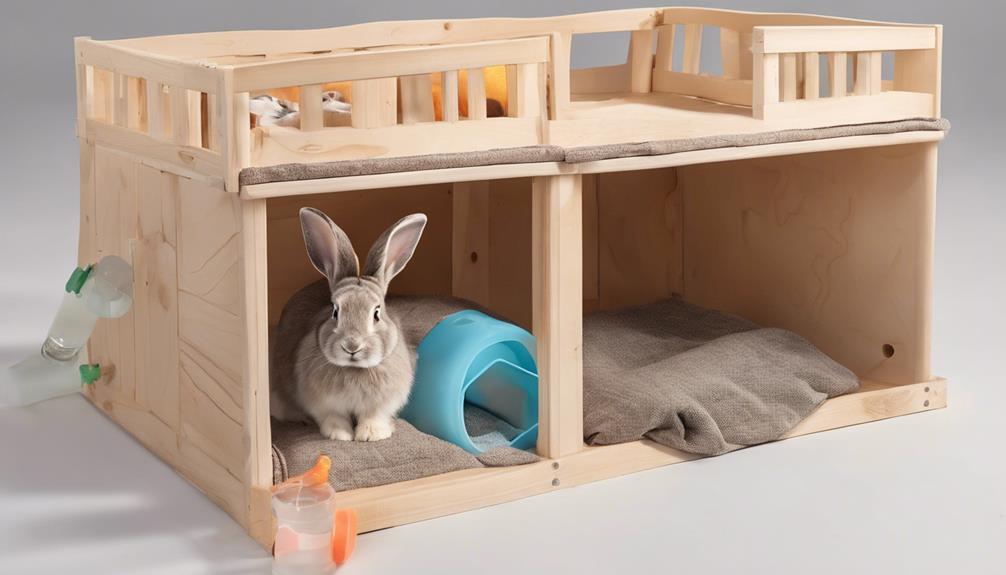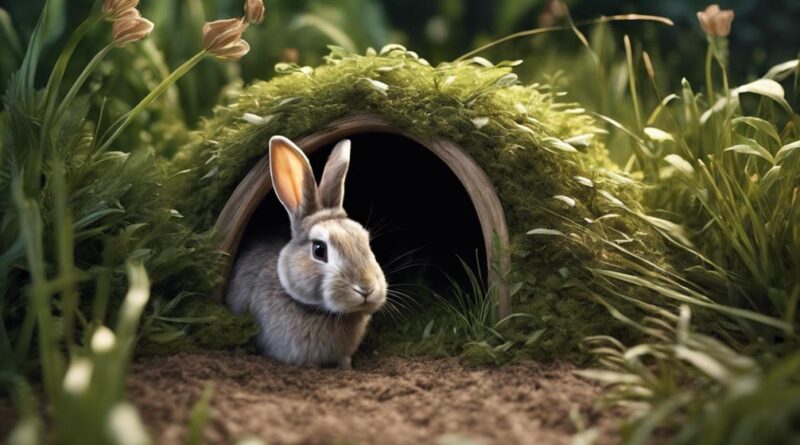Secure Hideaways for Your Anxious Rabbit Pets
When creating secure hideaways for your anxious rabbit pets, prioritize their comfort. Match the shelter size to your rabbit's needs and space restrictions, allowing easy access. Choose durable materials like sturdy wood or plastic to withstand chewing. Place the hideaway in a calm, quiet spot, enhancing it with cozy bedding and toys. Ensure your rabbit can access all areas with ramps and platforms. Maintain cleanliness regularly and monitor your rabbit's behavior closely. By prioritizing your rabbit's well-being and providing a safe space, you can offer them comfort and security. More tips await to help you create the perfect haven for your beloved pet.
Benefits of Secure Hideaways
Secure hideaways offer anxious rabbit pets a safe and calming retreat to alleviate stress and promote a sense of security in their environment. These comforting retreats play a crucial role in providing anxiety relief for rabbits, helping them feel secure and safe within their living space. Rabbits are naturally skittish animals, and having a secure hideaway allows them to retreat when they feel overwhelmed or scared, offering them a sense of protection and comfort.
Anxiety relief is a significant benefit of providing your rabbit with a secure hideaway. Rabbits can easily get stressed by loud noises, sudden movements, or new environments. Having a designated safe space where they can hide and feel secure can help reduce their anxiety levels and promote a sense of calmness. This is especially important for rabbits that are easily startled or are new to your home.
Choosing the Right Size
When considering the right size for your rabbit's hideaway, it's important to match it to your rabbit's size and comfort needs. Size considerations play a crucial role in providing a safe and secure environment for your anxious rabbit pets. Ensure the shelter dimensions and enclosure requirements align with the space restrictions you have available.
Rabbits come in different sizes and breeds, so it's essential to choose a hideaway that accommodates your specific rabbit's dimensions. A hideaway that's too small can make your rabbit feel cramped and stressed, while one that's too large may not provide the cozy, secure feeling they seek. Consider your rabbit's size when selecting the appropriate shelter to ensure they've enough space to move around comfortably.
Space restrictions in your home should also guide your decision when choosing the right size for your rabbit's hideaway. Measure the area where you plan to place the shelter to ensure it fits well and allows for easy access for both you and your rabbit. Additionally, consider any enclosure requirements such as additional space for toys, food, and water bowls within the hideaway to create a comfortable and functional environment for your anxious rabbit pets.
Material Matters for Safety
Choosing the right material for your rabbit's hideaway is crucial for ensuring their safety and well-being. When selecting materials for your rabbit's hideaway, prioritize durability to withstand your rabbit's activities and ensure longevity. Opt for materials like sturdy wood or durable plastic that can withstand chewing and scratching without posing a danger to your pet. These materials provide a safe environment for your anxious rabbit to retreat to when feeling overwhelmed.
In addition to material durability, consider the size flexibility of the hideaway. Your rabbit may feel more secure in a cozy, enclosed space during stressful times. However, they may also appreciate having enough room to stretch out comfortably. Look for hideaways that offer a balance between a snug fit for security and ample space for movement. This way, your rabbit can choose the environment that suits their mood while feeling safe and protected.
Location Tips for Calmness
For a sense of calmness in your rabbit's hideaway, consider the strategic placement within your home to promote relaxation and security. Whether you opt for an outdoor sanctuary or an indoor one, the location plays a crucial role in your rabbit's well-being.
When setting up an indoor sanctuary, aim to choose a quiet and peaceful area away from loud noises and high traffic. Natural light is beneficial, but ensure there are shaded spots for your rabbit to retreat to if they prefer. Avoid placing the hideaway near air vents or radiators to prevent temperature fluctuations that may cause stress.
On the other hand, if you're creating an outdoor sanctuary, pick a sheltered spot that provides protection from the elements. Ensure the area is secure from predators and that your rabbit can't dig its way out. Additionally, consider adding natural elements like plants or rocks to mimic their natural environment and create a soothing atmosphere.
Whether indoors or outdoors, the environment should be free from strong odors, such as cleaning products or cooking smells, as rabbits have sensitive noses. By carefully selecting the location and paying attention to these details, you can provide a safe and calming hideaway for your anxious rabbit pet.
Enhancing With Comfort Items
Looking to create a cozy haven for your anxious rabbit buddy? Enhancing their space with cozy additions and relaxation essentials can greatly improve their sense of security and well-being. Here are some tips to make your rabbit's hideaway a comforting retreat.
Start by adding soft bedding materials such as hay or straw to create a warm and comfortable base for your rabbit to rest on. Consider providing a cozy blanket or towel for them to snuggle into, offering an extra layer of comfort. Rabbits love to burrow and nest, so providing them with opportunities to do so can help alleviate anxiety.
Incorporating items like chew toys, tunnels, and hiding spots can also enhance your rabbit's environment. These additions not only provide mental stimulation but also offer a sense of security by giving your rabbit places to explore and hide when feeling overwhelmed.
Another essential comfort item to consider is a cozy hideout or shelter within their enclosure. This can be a small hut, a cardboard box, or even a fabric tunnel where your rabbit can retreat to when they need some alone time. Having a safe space to retreat to can help reduce stress and promote relaxation.
Ensuring Accessibility Inside
To ensure your anxious rabbit's comfort and well-being, make sure their hideaway is easily accessible inside their enclosure. Accessibility solutions are essential to create a stress-free environment for your furry friend. Consider adding cozy additions like ramps or platforms to help your rabbit access their hideaway with ease. These additions not only improve accessibility but also provide opportunities for exercise and exploration within their enclosure.
Privacy options are crucial for rabbits to feel secure and reduce anxiety. Incorporating hiding spots such as tunnels or hidey-holes inside their hideaway can give them a sense of security. Ensure these areas are easily accessible and placed strategically within the enclosure to allow your rabbit to retreat to a safe space whenever they feel overwhelmed.
Calming techniques can also be implemented to enhance accessibility inside your rabbit's hideaway. Soft bedding materials, soothing scents, and gentle lighting can create a relaxing atmosphere for your pet. These elements can help reduce stress and make the hideaway a welcoming retreat for your anxious rabbit.
Cleaning and Maintenance Guide

When maintaining your anxious rabbit's hideaway, ensuring cleanliness and proper upkeep is vital to promote a healthy and comfortable living environment. To keep your rabbit's hideaway clean and organized, here are some cleaning tips and maintenance guidelines to follow.
For effective cleaning, establish a regular maintenance schedule to ensure your rabbit's hideaway remains a safe and hygienic space. Cleaning the hideaway at least once a week is recommended to prevent the buildup of dirt, droppings, and odors. Use pet-safe cleaning supplies to wipe down surfaces and remove any messes promptly.
Organization plays a key role in maintaining a tidy hideaway for your anxious rabbit. Keep all necessary cleaning supplies such as wipes, brushes, and pet-safe disinfectants nearby for quick access. Implement storage solutions like baskets or bins to store toys, hay, and other essentials neatly.
When conducting deep cleaning sessions, consider removing your rabbit temporarily to a safe and secure area to prevent stress. Thoroughly clean and sanitize all surfaces, including the bedding, toys, and food/water dishes. Check for any signs of wear and tear in the hideaway and repair or replace as needed.
Monitoring Your Rabbit's Behavior
To properly care for your anxious rabbit, observe and understand its behavior by monitoring daily habits and reactions. Behavior monitoring is crucial in identifying any stress signals your rabbit may be exhibiting. Rabbits, like many animals, communicate through their behaviors, and being attuned to these cues can help you provide a safe and comfortable environment for your furry friend.
Pay close attention to your rabbit's eating habits. Changes in appetite can indicate distress or health issues. Ensure your rabbit has access to fresh hay, water, and a balanced diet. Additionally, monitor their litter box habits. Any significant changes in urination or defecation patterns could signal an underlying problem that needs attention.
Another important aspect of behavior monitoring is observing how your rabbit interacts with its environment and with you. Is your rabbit more withdrawn than usual, or is it displaying signs of aggression? These behavioral changes can provide insights into your rabbit's emotional state. Creating a calm and quiet space for your rabbit to retreat to can help alleviate stress and anxiety.
Frequently Asked Questions
Can Rabbits Share a Hideaway With Other Pets?
In a multi-pet household, consider rabbit behavior and socialization when deciding if they can share a hideaway with other pets. Rabbits generally prefer their own space and may feel stressed if forced to share. It's important to prioritize their comfort and safety.
While some rabbits may tolerate sharing a hideaway with other pets, it's best to provide separate secure hideaways to ensure they've a stress-free environment to retreat to when needed.
How Often Should Hideaways Be Replaced?
When it comes to hideaway durability, it's recommended to replace them every 6-12 months to ensure your rabbit's safety and comfort. Rotating hideaways also helps prevent boredom and provides a fresh environment for your pet.
Are There Hideaways That Can Be Used Outdoors?
When it comes to outdoor options for hideaways, it's essential to prioritize weather durability. Look for sturdy materials like weather-resistant wood or plastic that can withstand different elements.
Make sure the hideaway provides proper ventilation and protection from rain or direct sunlight. Your rabbit will appreciate a safe and cozy spot outdoors that can withstand the changing weather conditions.
Should Hideaways Be Scented for Rabbits?
When it comes to scented hideaways for rabbits, it's important to consider whether the scent could be beneficial or harmful. Keep in mind that rabbits have sensitive noses, so strong scents mightn't be their preference.
Some rabbits may enjoy a lightly scented hideaway, while others might prefer unscented options. It's essential to observe your rabbit's behavior to determine their preference and ensure they feel comfortable and secure in their hideaway.
Can Hideaways Help With Bonding Between Rabbits?
Hideaways can play a significant role in bonding between rabbits. These secure spaces offer comfort and safety, allowing rabbits to relax and build trust with each other.
By providing hideaways, you create opportunities for your rabbits to socialize, engage in playtime activities, and develop strong bonds. Incorporating bonding techniques and socialization tips into their routine can enhance their relationship and overall well-being.
Prioritizing these interactions can lead to happier and healthier rabbits.
Conclusion
In conclusion, providing secure hideaways for your anxious rabbit pets is essential for their well-being and comfort. By choosing the right size, material, and location, you can create a safe space where your rabbit can relax and feel secure. Adding comfort items and ensuring accessibility inside will enhance their experience.
Regular cleaning and monitoring your rabbit's behavior will help maintain a peaceful environment for your furry friend. Your efforts will be rewarded with a happier and more content rabbit.
